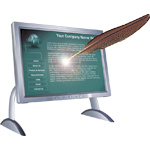There are a number of definitive and essential stages to designing or upgrading a web site. The answers to why do you want a web site, what should it say, what will users get out of it, how it should look & feel, how will users get around it, and how will you market it all need to be decided before even the first draft layout.
Over the years, HawkFeather Web Design has developed a process that can easily find the answers to these questions, without using overwhelming technical lingo.
- Planning: What is the goal for your Web site - what can it do for you? What information do you want available? Who is your clientele? Some common themes are:
- Offer your products or services.
- A rapid & cost-efficient alternative to phone or mail.
- Present information ranging from on-line manuals to special interest groups.
- Design: What look-n-feel is appropriate for your business? How do you best organize the content so viewers can easily & intuitively access the information they desire? After the planning & design phases, an estimate of overall budget can be generated.
- Style: Do you want to place your current information on the Web? Do you want to generate new materials or a new look? Be it formal, high tech or bold, color & tone should be consistent across your site, and project your image in the best light.
- Navigation: A clear and concise navigation structure is vital for your users to easily find the information they're seeking. Always create a flow chart - and if need be storyboards - to delineate the functions & links.
- Content: This requires a good writer who embodies the spirit of the client, and who has editorial control of style & content to best suit the Web's requirements.
- Graphics: Graphics are perhaps the most important feature of a Web site, and yet are commonly adapted from print, ignoring the specifics of Web design.
- Search Engine Optimization: Your pages need to contain both visible and invisible keywords that makes your information highly relevant to search engines.
- Code: Frequently this is the only stage considered, and is usually accomplished using Web authoring programs. Yet these programs rarely generate fully Web compliant, cross-platform compatible or documented code, nor ensure easy maintenance & modification.
- Delivery: Draft & final. This requires a familiarity with Internet Service Providers (ISP's), servers & FTP.
- Notification: You need to let the world know who & where you are.
- Marketing: Now that your site is online, you need to generate effective results via search engines, directories, links and paid advertising. You also can generate leads, gather emails, and create a blog or newsletter campaign to keep the information timely & interesting.
- Maintenance: After your web site is live, you can check to see how it is being used and make modifications accordingly.
- Security & Backups: Is your site protected? Is its' software up to date? Has anybody tried or suceeded in compromising it? Are you ready to recover from a problem?
- Analysis: Who is visiting your site? What pages are they navigating? What keywords are they using? How do you stack up against your competition? What's your ROI?






